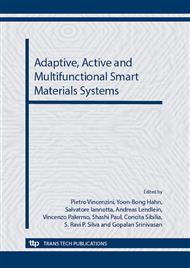[1]
J. Smith, J. Viken, S. Dollyhigh, A. Trani, H. Baik, N. Hinze, S. Ashiabor, The effects of projected future demand including very light jet air-taxi operations on U.S. national airspace system delays as a function of next generation air transportation system airspace capacity, NASA (2007).
DOI: 10.2514/6.2007-7785
Google Scholar
[2]
H. Akiyama, T. Sakugawa, T. Namihira, K. Takaki, Y. Minamitani, N. Shimomura, Industrial Applications of pulsed power technology, Dielectrics and Electrical Insulation, IEEE Transactions on. 14 (2007) 1051-1064.
DOI: 10.1109/tdei.2007.4339465
Google Scholar
[3]
S. H. Zhang, C. Zou, X. Zhou, D. Anderson, B. Zellers, Q. M. Zhang, Polymer film capacitors with high dielectric constant, high capacitance density, and high energy density, Power Modulator and High Voltage Conference (IPMHVC), 2010 IEEE International (2010).
DOI: 10.1109/ipmhvc.2010.5958333
Google Scholar
[4]
T.H. Hubing, J.L. Drewniak, T.P. Van Doren, D.M. Hockanson, Power bus decoupling on multilayer printed circuit boards, Electromagnetic Compatibility, IEEE Transactions on. 37 (1995) 155-166.
DOI: 10.1109/15.385878
Google Scholar
[5]
J.Y. Li, L. Zhang, S. Ducharme, Electric energy density of dielectric nanocomposites, Appl. Phys. Lett. 90 (2007) 132901.
DOI: 10.1063/1.2716847
Google Scholar
[6]
J. Li, J. Claude, L. Norena-Franco, S.I. Seok, Q. Wang, Electrical Energy Storage in Ferroelectric Polymer Nanocomposites Containing Surface-Functionalized BaTiO3 Nanoparticles, Chemistry of Materials. 20 (2008) 6304-6306.
DOI: 10.1021/cm8021648
Google Scholar
[7]
H. D. Chen, K.R. Udayakumar, L.E. Cross, J.J. Bernstein, L.C. Niles, Dielectric, ferroelectric, and piezoelectric properties of lead zirconate titanate thick films on silicon substrates, Journal of Applied Physics. 77 (1995) 3349-3353.
DOI: 10.1063/1.358621
Google Scholar
[8]
J. Li, S. I. Seok, B. Chu, F. Dogan, Q. Zhang, Q. Wang, Nanocomposites of Ferroelectric Polymers with TiO2 Nanoparticles Exhibiting Significantly Enhanced Electrical Energy Density, Adv Mater. 21 (2009) 217-221.
DOI: 10.1002/adma.200801106
Google Scholar
[9]
Y. Lin, G. Ehlert, H. A. Sodano, Increased interface strength in carbon fiber composites through a ZnO nanowire interphase, Advanced Functional Materials. 19 (2009) 2654-2660.
DOI: 10.1002/adfm.200900011
Google Scholar
[10]
H. Tang, Y. Lin, H. A. Sodano, Enhanced Energy Storage in Nanocomposite Capacitors through Aligned PZT Nanowires by Uniaxial Strain Assembly, Advanced Energy Materials. 2 (2012) 469-476.
DOI: 10.1002/aenm.201100543
Google Scholar
[11]
M. Rabuffi, G. Picci, Status quo and future prospects for metallized polypropylene energy storage capacitors, Plasma Science, IEEE Transactions on. 30 (2002) 1939-(1942).
DOI: 10.1109/tps.2002.805318
Google Scholar
[12]
F. Guan, L. Yang, J. Wang, B. Guan, K. Han, Q. Wang, L. Zhu, Confined ferroelectric properties in poly(vinylidene fluoride-co-chlorotrifluoroethylene)-graft-polystyrene graft copolymers for electric energy storage applications, Advanced Functional Materials. 21 (2011).
DOI: 10.1002/adfm.201002015
Google Scholar
[13]
D. W. Callister, D. G. Rethwisch, Materials science and engineering: an Introduction, John Wiley & Sons, (2009).
Google Scholar
[14]
H. Tang, Y. Lin, C. Andrew, H. A. Sodano, Nanocomposites with increased energy density through high aspect ratio PZT nanowires, Nanotechnology. 22 (2011) 015702.
DOI: 10.1088/0957-4484/22/1/015702
Google Scholar
[15]
W. Li, Q. Meng, Y. Zheng, Z. Zhang,W. Xia, Z. Xu, Electric energy storage properties of poly(vinylidene fluoride), Appl. Phys. Lett. 96 (2010) 192905.
DOI: 10.1063/1.3428656
Google Scholar
[16]
J. Claude, Y. Lu, K. Li, Q. Wang, Electrical storage in poly(vinylidene fluoride) based ferroelectric polymers: correlating polymer structure to electrical breakdown strength, Chem. Mater. 20(2008) 2078-(2080).
DOI: 10.1021/cm800160r
Google Scholar
[17]
R. Gibson, Principles of composite material mechanics, Boca Raton : CRC Press, (2007).
Google Scholar
[18]
R. Gibson (Ed. ), Principles of composite material mechanics, Boca Raton : CRC Press, (2007).
Google Scholar
[19]
A. Kelly, W.R. Tyson, Tensile properties of fibre-reinforced metals: Copper/tungsten and copper/molybdenum, J. Mech. Phys. Solids. 13 (1965) 329-350.
DOI: 10.1016/0022-5096(65)90035-9
Google Scholar
[20]
J. Whitney, C. Browning, On short-beam shear tests for composite materials, Exp. Mech. 25 (1985) 294-300.
DOI: 10.1007/bf02325100
Google Scholar


